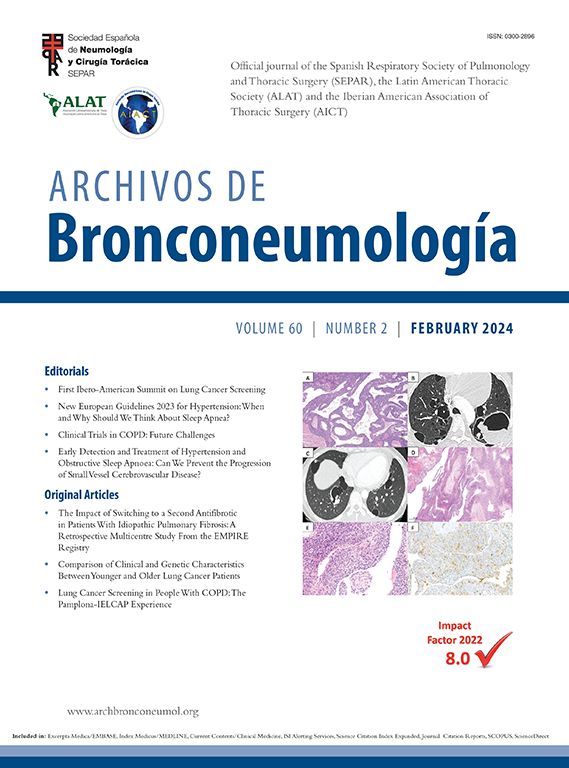Persistent Blood Eosinophilia and Eosinopenia: Relationship with Outcomes in Bronchiectasis
IF 9.2
3区 医学
Q1 RESPIRATORY SYSTEM
引用次数: 0
Abstract
Introduction
Blood eosinophil counts (BEC) have been related to the severity of bronchiectasis and its response to inhaled corticosteroids. However, only the baseline BEC has been used to assess this relationship and it is known that BEC could change over time. The objective of this study is to analyse the association of persistent eosinophilia or eosinopenia with outcomes in bronchiectasis.
Methods
Multicentre, prospective and observational study from 43 centres in Spain derived from the Spanish Bronchiectasis Registry (RIBRON). Asthma and anti-eosinophil treatments were excluded. Patients with at least two yearly BEC measures (including the baseline measure) were included. Persistent eosinophilia (at least 300 cells/μL) or persistent eosinopenia (less than 100 cells/μL) were defined as the persistence in the same eosinophil group after three yearly measures (being the baseline the first measure).
Results
Five hundred two patients with at least three BEC measures were included; 24.5% and 16.6% presented baseline eosinophilia or eosinopenia, respectively. Of these, 57.7% and 56.6% presented persistent eosinophilia and eosinopenia, respectively. Patients with persistent eosinophilia presented greater severity and a higher number/greater severity of exacerbations than those with non-persistent eosinophilia and those with persistent or non-persistent eosinopenia. Finally, patients with non-persistent eosinopenia presented more severity and a higher number/greater severity of exacerbations than those with non-persistent eosinophilia.
Conclusion
When only the baseline BEC was taken into account, patients with eosinopenia presented greater severity than those with eosinophilia. However, patients with persistent eosinophilia presented greater severity than those with persistent eosinopenia. Monitoring the BEC seems to be important in bronchiectasis.

持续性血嗜酸性粒细胞增多和嗜酸性粒细胞减少:与支气管扩张结局的关系。
血液嗜酸性粒细胞计数(BEC)与支气管扩张的严重程度及其对吸入皮质类固醇的反应有关。然而,只有基线BEC被用来评估这种关系,并且已知BEC会随着时间的推移而改变。本研究的目的是分析持续嗜酸性粒细胞增多或嗜酸性粒细胞减少与支气管扩张结局的关系。方法:来自西班牙支气管扩张登记(RIBRON)的43个西班牙中心的多中心、前瞻性和观察性研究。排除哮喘和抗嗜酸性粒细胞治疗。纳入了每年至少进行两次BEC测量(包括基线测量)的患者。持续嗜酸性粒细胞增多(至少300个细胞/μL)或持续嗜酸性粒细胞减少(小于100个细胞/μL)被定义为三年检测后在同一嗜酸性粒细胞组中持续存在(作为第一次检测的基线)。结果:纳入了至少三项BEC措施的520例患者;24.5%和16.6%分别表现为基线嗜酸性粒细胞增多或嗜酸性粒细胞减少。其中,57.7%和56.6%分别表现为持续性嗜酸性粒细胞增多和嗜酸性粒细胞减少。与非持续性嗜酸性粒细胞增多症和持续性或非持续性嗜酸性粒细胞减少症患者相比,持续性嗜酸性粒细胞增多症患者表现出更大的严重程度和更大的加重次数。最后,非持续性嗜酸性粒细胞减少的患者比非持续性嗜酸性粒细胞增多的患者表现出更严重的程度和更高的加重次数/更严重的程度。结论:当仅考虑基线BEC时,嗜酸性粒细胞减少患者的严重程度高于嗜酸性粒细胞增多患者。然而,持续性嗜酸性粒细胞增多的患者比持续性嗜酸性粒细胞减少的患者表现出更严重的症状。在支气管扩张中监测BEC似乎很重要。
本文章由计算机程序翻译,如有差异,请以英文原文为准。
求助全文
约1分钟内获得全文
求助全文
来源期刊

Archivos De Bronconeumologia
Medicine-Pulmonary and Respiratory Medicine
CiteScore
3.50
自引率
17.50%
发文量
330
审稿时长
14 days
期刊介绍:
Archivos de Bronconeumologia is a scientific journal that specializes in publishing prospective original research articles focusing on various aspects of respiratory diseases, including epidemiology, pathophysiology, clinical practice, surgery, and basic investigation. Additionally, the journal features other types of articles such as reviews, editorials, special articles of interest to the society and editorial board, scientific letters, letters to the editor, and clinical images. Published monthly, the journal comprises 12 regular issues along with occasional supplements containing articles from different sections.
All manuscripts submitted to the journal undergo rigorous evaluation by the editors and are subjected to expert peer review. The editorial team, led by the Editor and/or an Associate Editor, manages the peer-review process. Archivos de Bronconeumologia is published monthly in English, facilitating broad dissemination of the latest research findings in the field.
 求助内容:
求助内容: 应助结果提醒方式:
应助结果提醒方式:


